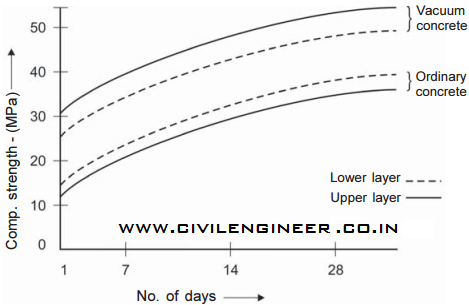
VACUUM CONCRETE: TECHNIQUES,
EQUIPMENTS & ADVANTAGES
Water-cement ratio is detrimental for concrete. We always try to restrict the water-cement ratio in order to achieve higher strength. The chemical reaction of cement with water requires a water-cement ratio of less than 0.38, whereas the adopted water-cement ratio is much more than that mainly because of the requirement of workability. Workability is also important for concrete, so it can be placed in the form work easily without honeycombing.
After the requirement of workability is over, this excess water will eventually evaporate leaving capillary pores in the concrete. These pores result into high permeability and less strength in the concrete. Therefore, workability and high strength don’t go together as their requirements are contradictory to each other.
Vacuum concrete is the effective technique used to overcome this contradiction of opposite requirements of workability and high strength. With this technique both these are possible at the same time.
In this technique, the excess water after placement and compaction of concrete is sucked out with the help of vacuum pumps. This technique is effectively used in industrial floors, parking lots and deck slabs of bridges etc. The magnitude of applied vacuum is usually about 0.08 MPa and the water content is reduced by upto 20-25%. The reduction is effective upto a depth of about 100 to 150 mm only.
Technique and Equipments for Vacuum Concrete:
The main aim of the technique is to extract extra water from concrete surface usingvacuum dewatering. As a result of dewatering, there is a marked reduction in effective water-cement ratio and the performance of concrete improves drastically. The improvement is more on the surface where it is required the most.
Mainly, four components are required in vacuum dewatering of concrete, which are given below:
- Vacuum pump
- Water separator
- Filtering pad
- Screed board vibrator
Vacuum pump is a small but strong pump of 5 to 10 HP. Water is extracted by vacuum and stored in the water separator. The mats are placed over fine filter pads, which prevent the removal of cement with water. Proper control on the magnitude of the water removed is equal to the contraction in total volume of concrete. About 3% reduction in concrete layer depth takes place. Filtering pad consists of rigid backing sheet, expanded metal, wire gauge or muslin cloth sheet. A rubber seal is also fitted around the filtering pad as shown in fig.1. Filtering pad should have minimum dimension of 90cm x 60cm.
Fig. 1: Vacuum dewatering of concrete
Advantages of vacuum concreting:
- Due to dewatering through vacuum, both workability and high strength are achieved simultaneously.
- Reduction in water-cement ratio may increase the compressive strength by 10 to 50% and lowers the permeability.
- It enhances the wear resistance of concrete surface.
- The surface obtained after vacuum dewatering is plain and smooth due to reduced shrinkage.
- The formwork can be removed early and surface can be put to use early.
Fig. 2: Effect of vacuum dewatering of concrete
The advantages of dewatering are more prominent on the top layer as compared to bottom layer as shown in fig. 2 above. The effect beyond a depth of 150mm is negligible.


Good article about vacuum concrete. One can also get more information about vacuum dewatered concrete at tremix flooring and vacuum dewatered concrete